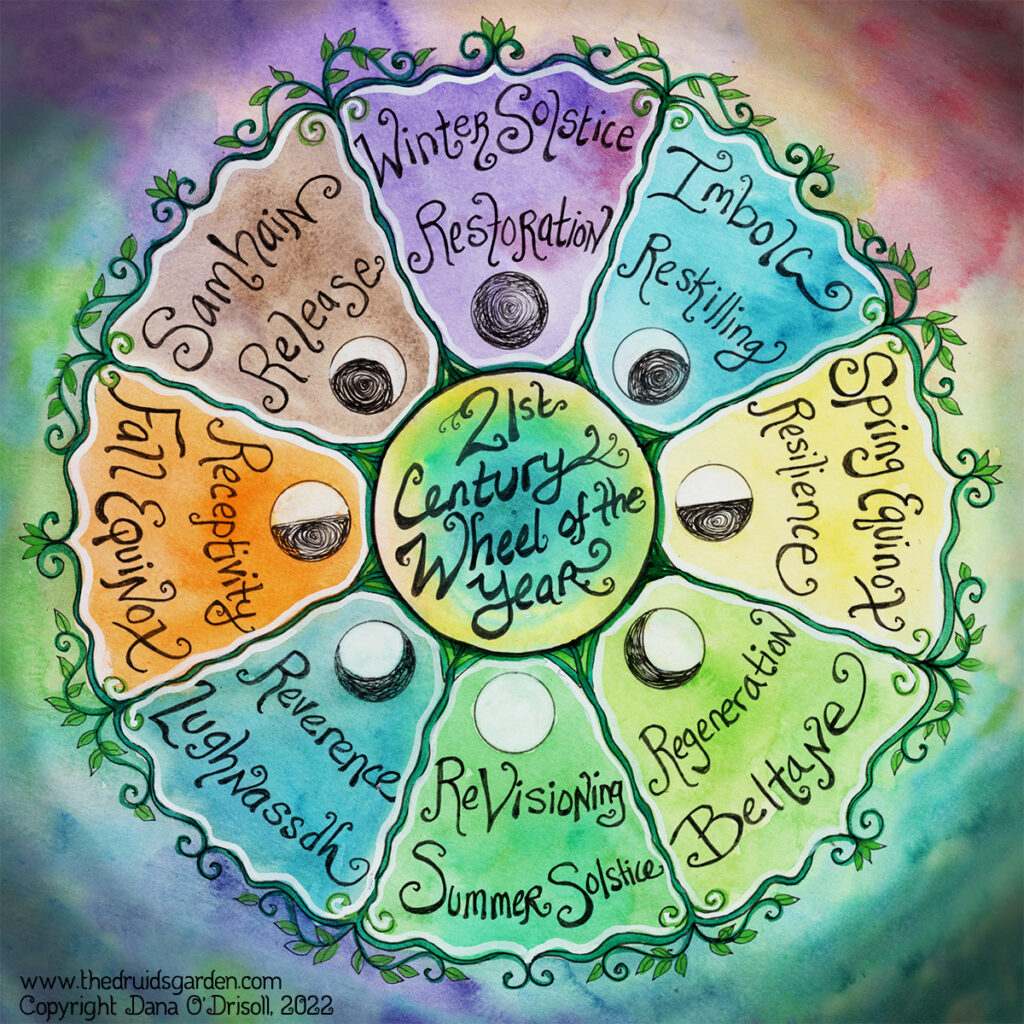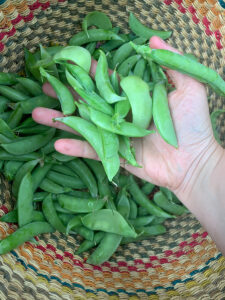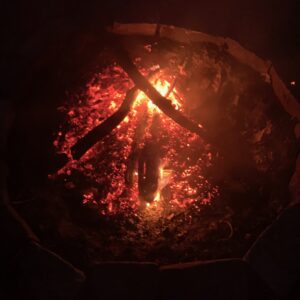Many of us are now going deeper into the experience of climate extremes. In the summer months here in the US, we are experiencing heat, lack of rain, and drought-like conditions. It is hotter and drier, and that creates stress on plants, animals, and the land. Cracks appear in the earth, plants wilt and wither away, and stream beds dry up. And then, after enduring these conditions, it rains. Even a little rain in these hot and dry conditions is a blessing. You run in it, dance in it, frolick in the rains that bring life back to the land. You raise your hands to the sky, allowing the cool drops to fall on your face, running down your arms. You hear the land breathe a sigh of relief, and the petrichor (the smell of the rain hitting the land) fills the air. This kind of experience fills you with reverence for the rain and the living earth. This kind of experience–an experience of scarcity–is part of what creates deep reverence.

Today’s post–the final in my 21st Century Wheel of the Year series, focuses on practicing reverence at Lughnasadh. The series began almost a year ago, and we’ve gone the whole wheel around, exploring key concepts, rituals, practices, and spiritual insights for how to adapt the traditional wheel of the year to the age of the Anthropocene. These themes are:
- Receptivity at the Fall Equinox
- Release at Samhain
- Restoration at the Winter Solstice
- Reskilling at Imbolc
- Resilence at the Spring Equinox
- Regeneration at Beltane
- Revisioning at the Summer Solstice
- Reverence at Lughnasadh (this post!)
As we continue to deepen our descent into the age of the Anthropocene, these themes–and many more–will be critically important to find our balance, grounding, and focus.
Reverence
 Reverence is the practice of deep respect, which includes gratitude, honoring, and reciprocation. To revere something is to hold that thing sacred–recognizing its deep and intrinsic value–and allowing us respectful interaction and experience. For those practicing nature spirituality, reverence towards the earth and everything on it is often a natural extension of our philosophy. For many, reverence is something you deepen over time, a practice that continues to grow the more you connect with the living earth both physically and spiritually. I also think that reverence is a big part of building deep connections between ourselves and the living earth. Part of a foundation of connection is founded on mutual respect and honor. But, reverence is also something we can work to practice and make a focal point of our lives.
Reverence is the practice of deep respect, which includes gratitude, honoring, and reciprocation. To revere something is to hold that thing sacred–recognizing its deep and intrinsic value–and allowing us respectful interaction and experience. For those practicing nature spirituality, reverence towards the earth and everything on it is often a natural extension of our philosophy. For many, reverence is something you deepen over time, a practice that continues to grow the more you connect with the living earth both physically and spiritually. I also think that reverence is a big part of building deep connections between ourselves and the living earth. Part of a foundation of connection is founded on mutual respect and honor. But, reverence is also something we can work to practice and make a focal point of our lives.
Reverence is a particularly salient theme at Lughnasadh, which has traditionally been considered the “first harvest” festival. The act of harvest is also an act of gratitude–being grateful for the bounty that the earth and the plants provide. For those that continue to grow their own food, engage in wild food foraging, or participate in other kinds of harvests–the gratitude that you experience as you gather nourishing food from the earth is palatable. Even those of us who do not participate in these activities at present can still work to directly cultivate reverence towards the living earth in our lives. Regardless of our life circumstances, focusing on reverence, respect, and gratitude at this holiday is a great way to attune ourselves with the energy of the season and re-affirm our relationship to the land.
One of the big things missing culturally is reverence. If we had reverence for the earth, would the earth be in such peril? If we had reverence for things coming from the earth, would we consume much less of it? In the age of the Anthropocene, reverence and gratitude is in extremely short supply, where it seems that an over-abundance of stuff, input, and things demanding our attention and energy pushes us in very different directions. It is hard to have reverence when you are literally bombarded at all times by too much stuff and an overabundance of media–it makes us a bit numb to the things that ARE important. We are drowning in waste, in stuff, and that can create a sense of feeling overwhelmed rather than grateful. That’s why I started this post with a discussion of rain after a drought–because experiencing the rain after weeks or months of no rain is a lesson in gratitude. Scarcity creates a kind of natural respect in us, it creates gratitude and reverence. When we have the opposite of scarcity–a world full of meaningless stuff–its hard to practice reverence.
But the other part of why reverence is important deals with the age of the Anthropocene and how we navigate these difficult times. Reverence is a balm to the numbness and apathy of the present age–it helps us connect, stay focused, and ground. It reminds us of what is important and what is not, and allows us to focus our attention on the things that are truly important. And of course, it provides a very necessary balm to our living earth and her spirits who are very much in peril.
Reverence, Offerings, and the Harvest

One of the most fundamental practices of reverence throughout the ages is through offerings. In cultures across the world, offerings are made surrounding the harvest season–often, this offering is a portion of the harvest that is returned to the land in gratitude. Offerings may also be made at other times of year, such as the offering of apple cider during wassailing in January.
I find that it is a useful practice to regularly reflect on what you want to offer. Offerings vary quite widely by person and tradition, and can be symbolic, energetic, or physical.. I’ve long argued that while symbolic offerings are important, offerings of time and physical energy are most useful in an age where nature needs so much help from us.
- Symbolic offerings include things like an herbal offering blend (see more below), wine, water, cider, cakes, a pinch of cornmeal, or other such offerings. Symbolic offerings can help habituate you into a regular reverence practice (especially if you carry an offering back with you)
- Energetic offerings allow you to “give back” energetically by raising and directing energy to benefit the land. These might be rituals, prayers, sacred song and dance, drumming and music, or any other ways that we raise and direct energy.
- Physical offerings are when you donate your time and energy to restoring, healing, and supporting the earth. This might include river cleanup, tree planting, or removing invasive species by hand.
It is useful to meditate and reflect on the kinds of offerings you make and try to make some offerings that fit in all three categories. I have also found it easier to move beyond reverence practices as a simple 1-1 relationship. What I mean by 1-1 is that I find some woodland nettle in the woods, and I want to pick some. So I ask permission, and when the woodland nettle agrees, I offer gratitude and an offering for the harvest. That’s a simple reverence practice–I want something so I offer gratitude. While it is important to do this, it is more connected if you develop a longer relationship with the larger spirit of woodland nettle–returning later in the season to scatter seeds, to spend time with the plant outside of the relationship of harvest, and to learn from the plant–to cultivate relationship. I see reverence and sacred relationship as intertwined in these ways.
Reverence Rituals and Activities at Lughnasadh
So, how do we go about building more reverence into our spiritual practices and overall life? The overall goal is to build reverence into our lives each day, but this can take time to build up to. I would suggest a layered approach to building in reverence.
Earth Reverence Lughnasadh Ritual

An earth reverence ritual is any ritual where we make known to the earth our reverence, gratitude, and respect. There are a wide variety of ways you can engage in this kind of work, and I’ll share one such way here. The ritual I describe is more ecstatic than solemn, but I think is an excellent example of an energetic offering that you can support.
Find a space outside where you can be alone–ideally one where you can set up an altar and build a fire. For materials, you will want some kind of symbolic offering that you can offer the fire (e.g sticks, cedar boughs, a pinch of herbal blend, high-proof alcohol). You will also need a divination system (tarot, oracle, pendulum, etc).
Light your sacred fire. Open a sacred space (as befitting your tradition; I use AODA’s solitary grove opening).
Begin by sharing your gratitude to the earth, and as you do, make an offering to the fire. For example, “I thank the earth for the rains upon our land today.” <Make offering>. “Thank the earth for the clothing on my back.” <make offering>. Continue to express your love and gratitude as long as you wish.
Raise energy by any means you choose, and radiate that energy out to the land. This could include dancing around the fire and as you dance, sending that energy into the earth with your feet. It could include singing, drumming, visualizing energy that is sent–any method that you feel led to do. Spend as much time as you feel led to send that energy.
Listen to the voices of the spirits for a message. For this, use the divination system you brought or contact the spirits directly.
Close your space and eat something to ground after the experience.
Note: If you don’t have such an outdoor space, you can do the ritual indoors adapting it. For an indoor ritual, have a bowl or cauldron in the center instead, and put each pinch of offering in the bowl as you speak. Raise energy for the earth as you feel led–regardless of where you raise it, the spirits will experience it! You can later take these offerings outside to the land directly after the ritual closes.
Herbal Offering Blend
Lughnasadh is a fantastic time to create your own herbal offering blend. An herbal offering blend can be any mixture of herbs, but make sure you are using only flower, stem, or leaf material–you do not want seeds in your blend, as this may inadvertently spread seeds to areas that they shouldn’t be. For my herbal offering blend, I grow a number of sacred herbs that smell and look wonderful. Common in my blend are mints (I especially like mountain mint and spearmint), rose petals, mugwort leaf, sacred tobacco, sages, and sweetgrass. I harvest these at or before Lughnasadh, dry them, and then blend them. I try to blend enough for a full year’s use. As part of the herbal offering blend, I do a small ritual where I offer gratitude to the plants in the blend and then offer an elemental blessing to empower the herbs for the year (more on this technique here). After making the blend, I put it in a small leather pouch which I keep with me.
Reverence Meditation
It can be useful this time of year to meditate on what reverence means to you. I like to meditate on the concept itself as well as related concepts: gratitude, respect, and connection. Consider doing this as a lunar meditation under the harvest moon. Use insights gained from it to help you develop other practices.
Committing to a Reverence Practice
Another practice that you can engage in on Lughnasadh is a personal commitment to a regular reverence practice. You should think carefully about what you can commit to–it is better to commit to something smaller that you can sustain than something larger that you cannot. You can meditate on this, go on a journey to help you decide, work with spirits, share with a sacred friend–initiate that process prior to Lughnasadh and begin that practice on Lughnasadh.
Sample practices might include:
- Creating a reverence altar and tending it
- Making a commitment to create and carry an offering blend
- Building in deep gratitude practice (see link)
- Working on practicing gratitude both in nature and in the human realm (making it a point to be thankful and grateful for people in your life)
Conclusion
It’s hard to believe that this series wraps up with this post–but now, we have the full 21st-century wheel of the year with new themes for this present age–and to help us envision and bring about a brighter future. Now that we’ve come the full way around the wheel, I’d love to hear how this alternative wheel of the year has worked for you. Do you resonate with it? Did you try any of the practices? Do you see concepts that perhaps we should explore next?
PS: I will be taking several weeks’ hiatus from the Druid’s Garden blog for working to finalize a new Land Healing book going to my publisher, some travel and R&R after this post–see you in late August!



Do you have suggestions for including alternatives to fire in the ritual? It’s been so, so dry, and I don’t want to set the world ablaze any more than it already is… *wry laugh*
I like her idea of a Cauldron for the offerings. I will share them to the land after the ceremony!
Hi Willow Croft, yes! You can just use an offering vessel or cauldron and then offer them to the land after the ceremony. You could also go to a river or lake and make natural offerings into the waters.
Thanks!
Hi! Maybe sunwheels, red,yellow. orange stones, cloth or paper, images of flame or sun. I guess symbolic and sympathetic magic!
Thank you, Dana. I look forward to your Sunday posts. I will go back and read the installments I missed (the new Wheel of the Year). Your writing is sustaining in very chaotic times.
Thank you, Cynthia! I’m glad that you like the Druids’ Garden blog :). Thanks for commenting and your kind words!
Enjoy the break Dana. I will go back and read through all the wheel of the year posts again to refresh my memories while you’re gone. And I will start working on my 2nd degree in AODA! So happy I finally made the decision to join after years of peeking through the hedge and practicing the 1rst degree Curriculum on my own. I made sure to fullfill all the unique things before I asked for the Transfer Credit Option (OBOD druid here).
Hi Claudia,
That sounds great! Do get the transfer credit approval done soon for AODA–we are eliminating that option after Dec 21, 2022 (for various reasons I can share). Blessings to you!
Thank you for letting me know Dana, it’s all arranged with Claire. Maybe you can share the reasons for this decision and send me an email, if your time allows. It might be helpful for me so I will know how to better work on the 2nd degree.
I liked it very much… except for the “invasive species” part. Too often people want to kill every migrating plant and animal, believing that the only “good” ones are the ones believed to have been in the area when the Europeans invaded.
I like far better the mindset of my herbalist son who says when you need healing, look outside, the plants you need will be there.
Once I looked up every plant on the invasive species list for my county and every single one had healing qualities.
♥️
Hi Marigold,
I’m right there with you. We do have some species that are very destructive to ecosystems, and I have no problem removing them by hand (no chemicals, etc). I’m thinking about things like Kudzu and Bittersweet, which literally tear down forests. I’m happy to put in the legwork to remove some of this. But most of the species are here, they are abundant, and they are great food and medicine. They are now part of our ecosystem and we need to make peace with that. Also most so-called invasive species are opportunistic, and they are taking opportunities caused by human destruction of the land. Thus, invasive species is a human construction to offload our own mistreatment of the land (and resulting consequences) by pinning it on plants. I’ve shared more of my perspective on this a while back here: https://thedruidsgarden.com/2014/10/09/invasive-plants-and-invasion-biology-as-destructive-concepts-a-druids-perspective/
Thank you for sharing your thoughts and blessings to you!